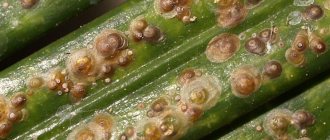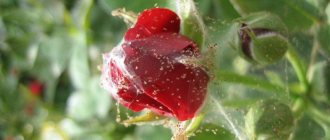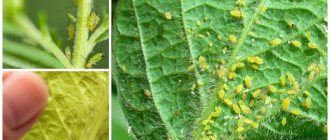- What is a spider mite and how does it reproduce? Life cycle of a spider mite.
- How are spider mites harmful to the plant?
- How can you tell if a plant is infected with spider mites? Symptoms of spider mites.
- How to treat a plant for spider mites? Means to combat spider mites.
- Fighting spider mites in the apartment.
- Folk remedies in the fight against spider mites. My processing scheme.
- Pros and cons of my scheme.
Now has come that time of year when even a tick can easily be “inflated” into an apartment by the wind from an open window.
Those who have trees near their windows/balconies are especially susceptible to this. Also, ticks can be “airborne” from neighbors above, because they are so light that they are carried by the wind like specks of dust. They can be brought in with a newly purchased plant, if it is not first quarantined. The biggest problem is fighting the tick, so, of course, it is better to prevent this matter.
I haven’t had any problems with mites for several years, since we moved to a new apartment, but this year I discovered a cobweb on the rose, and upon a detailed examination of the plants next to it, I also noticed disgusting living creatures.
What is a spider mite and how does it reproduce? Life cycle of a spider mite.
Spider mites are small insects whose size does not exceed 0.5 mm. It is very difficult to notice on a plant because with a small number of individuals, they rarely give themselves away, since they are very small and sit on the opposite side of the leaf. And even if we notice some dark grains, we most likely attribute it to careless watering and grains of soil getting onto the leaf. As a rule, the characteristic appearance of cobwebs means only one thing - there are too many ticks and they need to be dealt with immediately.
The tick reproduces very quickly: under favorable conditions, the female lays up to 250-300 eggs in 2-3 weeks, after which she dies. Favorable conditions for the development of spider mites are dryness and high temperature. The development cycle of a spider mite includes the following stages: egg, larva, protonymph, deuteronymph (in females), and adult. As a rule, from the very first stage (egg) to the adult individual it takes from 10 to 20 days, all other things being equal. So how does a mite harm a plant?
Should there be a web?
There are two types of spider mites with different claws - ordinary (black) and red. Both of them belong to the class Arachnids. Regardless of the subspecies, the characteristic cobweb always appears. Moreover, it can often be found on the inner (bottom) side, since this is where pests lay eggs, and the web is the protection of future offspring.
Additionally, like most arachnids, insects travel along plant branches with the help of webs. And huge populations, in principle, love to “sit” on their web.
How are spider mites harmful to the plant?
The spider mite is a living creature; it tends not only to reproduce, but also to feed. What does a spider mite eat? Everything is very simple, it feeds on the sap of the plant, piercing the leaf with its proboscis and releasing enzymes into it that destroy the chloroplasts of the cells.
As a result, the leaf becomes covered with brown dots, which soon merge into one large area, then the leaf dries out and falls off. From all this we can clearly conclude that the plant eventually loses its leaves and dies. And the mites will safely migrate to another neighboring plant.
Important! You should not think that the mite will sit only on the bottom of the plant until it is completely exhausted. There is a 99% chance that if you find a mite on one plant, it has already spread throughout the entire windowsill.
How can you tell if a plant is infected with spider mites? Symptoms of spider mites.
Let's look at the so-called symptoms of spider mite infestation. Unfortunately, the primary symptoms are nonspecific, so the tick is detected already when an obvious web appears.
- The appearance of brown spots on the leaves, as if the leaves were pierced with a thin needle.
- The presence of drying leaves on the plant, falling buds.
- Slowing down the development of the plant and its growth.
- Black or tan spots on the back of leaves that move.
- A web that weaves around parts of a plant and the underside of leaves.
- A cluster of individuals on a web (with a huge population).\
Ways to infect indoor flowers
A successful result in the fight against spider mites is guaranteed if the grower knows and understands the reasons for the appearance of the spider. Then the struggle will be successful. Various factors leading to plant infestation will help determine the type of mite and find effective ways to get rid of it.
A tick can get into an apartment or house from the street if there are trees and bushes growing nearby. It flies and quite often affects potted plants placed on the windowsill of an apartment.
There are many ways to penetrate and settle on indoor flowers:
- Store-bought package of floral substrate for plants.
- Store-bought plants or flowers transferred into a pot from the street.
- A gardener's or gardener's clothing can become a vehicle for pests.
- Gifted bouquet from the store.
The female or eggs of the spider can get into the flower pot during the cold season. When it gets warmer, the pest becomes more active and begins its vigorous life activity.
How to treat a plant for spider mites? Means to combat spider mites.
Of course, there are a large number of drugs that guarantee almost complete elimination of spider mites - these are the so-called acaricides and insectoacaricides. Let me make a reservation right away that they are effective not only against ticks, but also against other insect pests.
These drugs are both chemical (for example, Actellik and Fufanon) and biological (for example, Fitoverm and Akarin). Chemical and biological drugs have different active ingredients, but the principle of action is the same.
Both drugs are used three times, with a break of 5-10 days, because during the initial treatment the poison kills adult individuals, but the eggs are resistant to the substance and after a while hatch from the eggs and continue to exist on the plant.
This is interesting! There is also a very serious point that should not be forgotten - even adult mites acquire resistance to any drug over time, so it is recommended to do a control treatment with another drug, and not to treat plants more than once a year.
Important! You should be aware that it is undesirable to use chemicals in an apartment, because they have a negative effect on human health and have a very strong specific odor, the fumes of which are very harmful to inhale.
But what to do, since we are talking specifically about indoor plants, how then to treat the plants if the mite still appears on them?
Causes of the pest
Research has not shown any cause-and-effect relationship as to why a tick chooses a particular flower. An outdoor pest simply moves from nearby plants that are no longer useful to it. Therefore, there is no need to talk about any predisposition to certain types of plants.
But the reasons that increase the risk of infection are:
- purchasing low-quality pest-infested soil; placing pots on the street; open windows; proximity to the ground - private houses, first floors of high-rise buildings.
However, it has been noticed that some types of indoor plants are more preferable to spider mites. The risk group includes adenium, anthurium, fuchsia, violet, ficus, pelargonium, petunia, geranium and hydrangea, and the main delicacy for it is balsam. If marigolds or clematis grow in the garden, you should monitor indoor flowers even more carefully, because spider mites are a common problem for them.
Interesting! Spider mites are a big fan of fruit trees, so if you have them in your yard/garden/vegetable garden, the pest is more likely to appear on indoor plants.
Fighting spider mites in the apartment.
Since I try to write absolutely objective articles, it should be said that many gardeners used chemicals in the apartment. For example, in the summer season - on a balcony or loggia, which was then ventilated, and in the winter season - in the bathroom, which was locked at night to prevent contact with poisonous vapors. But keep in mind the fact that when spraying plants, poison will inevitably get on walls, hygiene items, and clothes. Yes, and the whole night the bathroom will be inaccessible to you, but what if you have a shared bathroom and you don’t live alone in the apartment? You can at least ventilate a balcony or loggia without any problems, but with a bathtub in this case it is much more difficult.
For me personally, this is not a solution, since I don’t want my family to suffer from my manipulations, and I only have one health. But with all this, I love my collection too much and giving up was not part of my plans.
Therefore, I have prepared a plan of action for myself, which, in my opinion, is not inferior in effectiveness to chemical treatment, but is absolutely safe for health.
Folk remedies in the fight against spider mites. My processing scheme.
Those who, like me, were looking for other ways to fight, I think more than once saw recipes against spider mites based on laundry soap, onion peels, garlic or even dandelion.
You should not be skeptical about these methods, since they help many people quite well, and my scheme is based on one of the above components.
Important! If you have a fairly impressive collection of plants (150 or more specimens), most likely, my method will not suit you. And if you need to process only 1-2 window sills, then the result will pleasantly surprise you.
Let me remind you that chemistry is not an option for me at all, and I was ready to do anything just to avoid poisoning myself and my household with it. Therefore, at first, I tried to follow the advice from the forums and, having treated the plants with a soap solution, wrapped them in a bag for several days (so that the solution would work), but after such treatment the mites came out again. It was stupid to hope that I would get them out the first time, but I still wanted to believe.
I won’t write to you about my torment and different options; I’ll probably move on to the scheme that I arrived at through trial and error.
There are quite a lot of plants in my collection, so I had to ask for help in selling it.
Important! To implement such a plan you will need 2-3 hours a week, depending on the number of copies. If you have a very small number of plants, then the time can be sharply reduced to 20-30 minutes per week.
All you need is laundry soap, water and a soft sponge. No packages needed!
- Transfer infected plants to the bath.
- Be sure to remove and wash the curtains, because... they come into contact with infected plants and may also harbor these pests.
Important! You only need to do this once. Moreover, when treating plants with chemicals, you will also have to wash the curtains if you do not want a relapse.This is interesting! A small life hack for curtains - you can hang them on the windows damp - this way they will dry on the window in their usual state and you won’t have to iron them.
- Fill a basin with warm water and be sure to wash the window and window sill, including glass, handles, etc., with laundry soap.
This is also done 1 time. Then you can do it as you wish, or you can not do it. I just wipe the window sill with soapy water. Important! Do not hang curtains before treating the window! - Now comes the hard part - processing the plants. You need to treat every pot and every plant. This is difficult because I don’t just spray the plants with a soapy solution or place a foam solution on the plant, but I soap a soft sponge so generously that there is a lot of soap and I rub each leaf as much as possible (!), I also rub the trunk, I check several times, so that everything without exception is soaped, I also soap the outside of the pot and a little of the top layer of soil. The first time, when processing, I left the plants in this state for 3-4 hours, the subsequent ones I simply soaped and washed off. Soaping is much easier than rinsing. Personally, it is not difficult for me to soap even a lush exotic ficus (it is not large-leaved). An hour after soaping, there is still a lot of soap on the plants.
Since I had a lot of plants, I had to wash them in parts: while one portion was being washed in the bathroom, the rest were waiting nearby. In this way I treated against ticks: drimiopsis, ficus, hibiscus, indoor rose, sorrel, begonias, fuchsias, chlorophytums, tradescantia, lemons and even mangoes.Important! Be sure to wash the back side of the sheet, because this is where spider mites settle.
Drimiopsis is completely soapy. Even fuchsia crumbs easily survived the soap procedures. The fuchsia buds were not damaged by the soap treatment, and the fuchsia bloomed a couple of days later.
I wash it off like this: I lay the plant carefully on its side, and wash out the soap with a sponge; I also wash off the pot and the top layer of soil (then you can add a new one). I carry out such manipulations with all plants, except thick-skinned ones, which cannot be washed (for example, not my haworthia, because water should not be allowed to get into the outlet). For plants that cannot be washed (for me these are succulents), I treat them with high-quality alcohol and wash the pot with soap.
Important! I wash it off in such a way that the soap does not get on the roots of the plants, otherwise they may die!
- After this, I return the plants to their original place.
But what is the scheme? Everything is very simple. Remember how we discussed the life cycle of a tick above?
So, after a week, there is a possibility that the mites that have not washed off will hatch, so you need to repeat the treatment of the plants and pots. This time I no longer wash the curtains or wash the windows, I just wipe the window sill a little with soapy water. I cover the soil with cling film so that soap does not get on the roots.
Cling film prevents soap from getting on the soil and roots.
It is much easier to wash off plants because the film protects the soil from soapy water.
Important! Such treatments must be carried out once a week for a whole month. That is, such treatment is carried out only 4 times per month. During this month, all ticks and eggs that might be present die and are washed away.
Preventative measures to prevent small bugs from appearing
Prevention measures are not particularly difficult:
- flowers need to be periodically inspected from the underside of the leaves;
- new crops purchased in a store should be kept in quarantine for several days;
- avoid waterlogging the soil;
- use drainage;
- do not allow the air in the room to become excessively dry;
- Spray regularly.
The measures taken will be quite enough to protect the flower from pest invasion. And if it does happen, there is no need to panic. Try to determine who exactly you are dealing with. And start fighting - the sooner the better.
Rate this post
Pros and cons of my scheme.
Any method has its advantages and disadvantages, and everyone chooses for himself whether it suits him, weighing the pros and cons.
Pros:
- Absolute safety for both your health and the health of your loved ones.
- A good result is that after a month the probability of relapse is less than 3%.
- Cheapness. One bar of soap is enough for all 4 treatments
Minuses:
- Inability to process large numbers of plants.
- A lot of time, it took me about 1 hour to process 1 window sill.
- Soap deposits on the leaves (can be removed with a damp cloth).
I hope you understand my principle of fighting spider mites.
Healthy plants!











